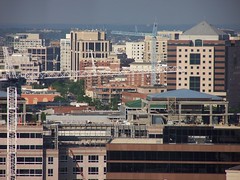 Arlington, urbanizing. |
Salon.com recently interviewed me for a story about emerging suburban downtowns. Here are some snippets:
Fact: People want to live in walkable urban places. Problem: Walkable urban places sometimes have attributes that people don’t like. Solution: Build new walkable urban places out in the suburbs. Result: A whole new type of place that offers the city experience without the actual city…
Some of them are in places like Rosslyn and Bethesda — close-in suburbs that developed an organic urban physicality over time… But the newer ones are in towns as far away as Reston and Tysons Corner in Virginia…
Daniel Malouff, editor of the blog BeyondDC, sees these WalkUPs as more like “starter cities” for suburbanites. “A place like Reston can introduce people who have grown up with suburbia to the idea of urbanism,” he says…
But does density and walkability alone make something urban? Though these outer-ring WalkUPs display many of the technical metrics of a city, most have an unmistakable suburban flavor…
But if WalkUPs promise an urban experience, it’s fair to ask what kind of urban experience they’re offering. “Any definition of urban you can think of, these places would qualify,” says Malouff. “But there’s clearly a difference.”…
The discussion about the authenticity of newly-built urban places has been going on since at least the late 1980s, when New Urbanism started to become a thing. On the one hand, new-built town centers are usually a touch sterile (especially if they’re built by a single developer all at once), and often disconnected from other urban places. On the other hand, they get better with age, and even Adams Morgan was a new place once upon a time.
I agree with the criticism that these places can sometimes feel forced, especially the ones like Bowie Town Center that are basically malls without a roof. But given the reality that our metropolitan areas jumped the suburban shark decades ago, and that millions of suburbanites cannot be expected to convert to Jane Jacobs urbanists all at once, whatcha gonna do? What other solution is there at the regional scale, except for incremental change in the right direction?
Our metropolitan areas aren’t going to change overnight, and we wouldn’t want them to anyway (it wouldn’t feel “real”). If our regions are going to change, it will be an incremental change.
That’s what’s so ironic about these town centers. Individually some of them lack the organic progression that would make them feel real. But taken in the regional context they are a legitimate step in precisely that sort of progression, part of a decades-long evolution of our metropolitan areas.
So whatever legitimate and true criticism of them is leveled, they’re still a good and necessary thing. The challenge for urban planners in the 21st Century will not be how to fight against these town centers, but rather will be how to improve them, and how to incorporate them in to a working, interconnected region.
September 24th, 2012 | Permalink
Tags: master planning, The New America













